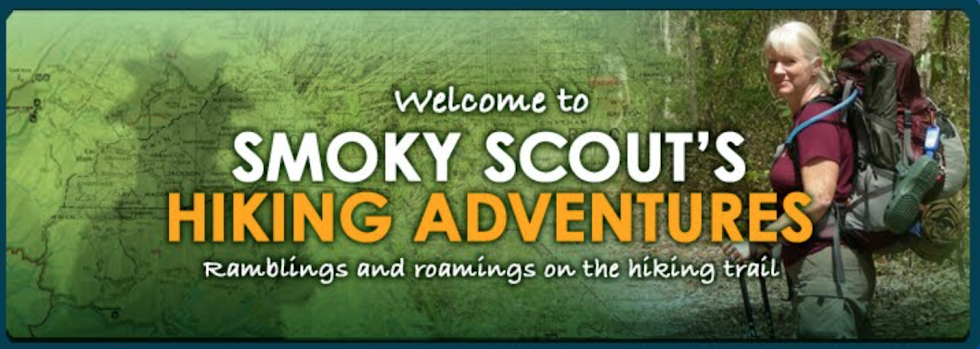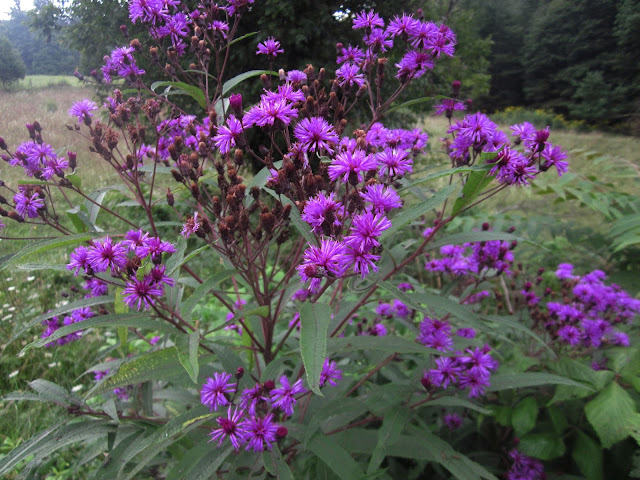Appalachian Trail Project in VA – 8/31/13 – Labor Day Weekend
– VA 630 to Craig Creek Road – 10.5 miles
Glacier National Park was great but there’s no place like
home, Dorothy! And I have a personal
hiking challenge to continue pursuing and a helpful husband willing to go
along. So just a few days after arriving
home from The West, a plan hatched – starting with Virginia Tech football. See, the Hokies were playing Alabama at the
Georgia Dome in Atlanta on Saturday and we didn’t have tickets. What is the next best place to watch the
game? At Hokie House in Blacksburg,
VA. And what is near Blacksburg? That’s right – the Appalachian Trail.
Very early on Saturday morning, with Jim’s bike and my
backpack in the car, we drove the scenic route to one of the many places where
the AT crosses the back roads between Pearisburg and Roanoke, VA. We love cruising these country roads past
farms and fields, me gazing at the nostalgic scenery and Jim evaluating the asphalt
rolling up and down with the ungraded terrain.
A good old-fashioned road map is essential because a GPS won’t find a
pull-off on narrow pavement after the third one-lane-wide bridge crossing. Since we’re starting a little late in the
morning and hoping to finish in time for a shower before kickoff, a 10-mile
hike seemed just about right. And while
I’m hiking Jim will be pedaling past the pastures.
At the first half-mile I reached a majestic old sentinel of
the forest called the Keffer Oak. Named
for Rex Keffer, a former landowner, the oak is one of the largest living trees
on the AT, estimated to be more than 300 years old and between 18 and 20 feet
in circumference. Nobody here to take a
picture of me beside it, but its size in relation to the fence says it
all. My hiker friend Judy likes to hug
big trees and thank them, so I patted old Keffer and thought of her.
Next the trail passed through open pasture with stiles over
fences (no cows today but evidence that this was their territory) and entered
the woods again at the base of Sinking Creek Mountain, where it switchbacked
steadily up, passing under power lines where more field flowers bloomed in
profusion.
The climb felt great, all that Glacier conditioning paying
off, heart pumping, legs working, sweat dripping, soaking wet (sounds like fun
so far?) At the top I settled into the
rhythm of a long ridge walk along Sinking Creek Mountain, called an unofficial
continental divide because the waters that flow down the western side of the
ridge flow via Sinking Creek Valley and the New River, ultimately to the Gulf
of Mexico, while the waters that course down the eastern side enter Craig
Creek, combine with the James River and eventually reach the Atlantic
Ocean. Isn’t nature perfect?
Don't have an explanation for this stuff laying beside the trail - I guess someone will be less comfy tonight?
Along the ridge I passed a pile of rocks, not randomly
scattered but intentional…then another… then another. My ATC Trail Guide calls this area Bruisers
Knob and explains that farmers cleared fields on the mountaintop, stacking them
to make way for crops and for other uses.
I’ve seen long stacked stone walls and fences in the woods before, but
not dozens of piles of rocks in such close proximity.
Hikers have strong opinions about Sarver Shelter. I had planned to stop at the shelter for
lunch, but the distance from the trail and the commentary convinced me to
continue to a more inviting location.
With a growling stomach I walked on.
Soon a view opened up as I climbed up a 10-foot rock
scramble onto a slanting rock ledge, and as I glanced left I saw the black body
of an animal – a dog? No, its hind foot
clearly looked like a hand, not a dog’s paw – a bear! Not a cub, but not super large either. Its rear end was toward me and I don’t think
it detected me. I slowly inched forward
as the bear walked around a curve in the rock.
(No photos, just trust me.)
I sat down right there to eat lunch. Let’s give the bear time to move on – and hope
his mama and siblings aren’t here for the buffet.
This rock slope continued on for a couple hundred yards with
small trees popping out here and there and many white asters and yellow late summer
flowers. Lizards darted around and I was
startled by an owl taking off close by, unusual for the middle of the day.
At the end of the ridge, the AT gently and steadily sloped
downward. I lost track of my progress a
little because I couldn’t find a particular stream crossing noted on the AT
guide. Finally I concluded that it was
dried up here in late summer.
Speaking of late summer, the fungus crop was gearing up –
this is chicken of the woods, easy to
identify and very edible
It wasn’t until I passed the Niday Shelter that
I got re-oriented to my route and knew that I was about a mile from the parking area on
Craig Creek Road where Jim was waiting for me.
(An interesting side note: back
in June 2011 I set up as a trail angel at this road crossing, handing out
doughnuts, bananas, soft drinks, etc. I
even had a couple of comfy tailgating chairs for hikers to rest a while and I
collected their trash. It was a little late
in the thru-hiker season, but about a dozen hikers stopped and chatted. Fun stuff.)
Half a mile to go and the thunder began to rumble so I
picked up my pace. As I put my pack and
poles in the car, large raindrops began to plop plop plop. Perfect timing. Ready for a shower, a beer, a burger and a
kickoff.
(P.S. Jim had a biking adventure that included a flat tire, a lift in a pickup truck and some good old country boys.)
(P.S. Jim had a biking adventure that included a flat tire, a lift in a pickup truck and some good old country boys.)
"What if the Hokey Pokey really is what it's all about?"


















No comments:
Post a Comment